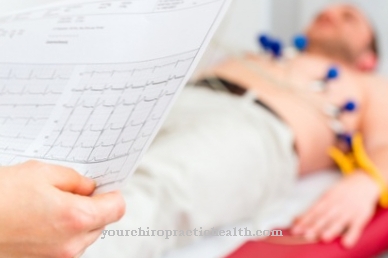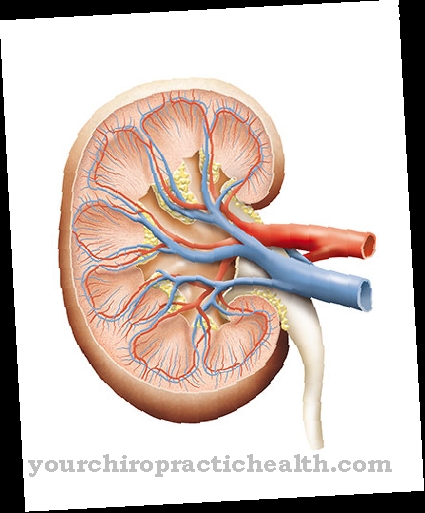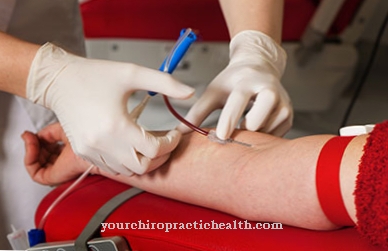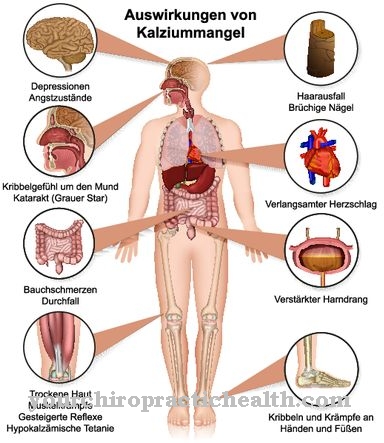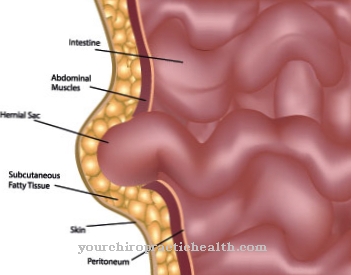At the Parry-Romberg Syndrome it is a disease that has a very low prevalence in the population. As part of the disease, the sick person develops progressive atrophy, which usually affects one half of the face. The atrophy develops continuously over a long period of time.
What is Parry-Romberg Syndrome?

© Lena Balk - stock.adobe.com
The Parry-Romberg Syndrome is also called in medicine Half-sided facial atrophy or Progressive facial hemiatrophy known. It is a very rare disease, the exact cause of which has not yet been adequately researched. As part of Parry-Romberg syndrome, those affected suffer from atrophy or hemiatrophy, which shows up on one half of the face.
The name of the disease is derived from the two doctors who scientifically described Parry-Romberg syndrome for the first time. These are Caleb Parry and Moritz Romberg. The exact frequency of Parry-Romberg syndrome has not yet been researched.
However, previous observations of patients show that Parry-Romberg syndrome affects female patients in the majority of cases. These are often relatively young. Around three quarters of the illnesses are found in women who have not yet completed their second decade of life.
causes
There are currently no medical research studies that address the exact causes of Parry-Romberg syndrome. The lack of knowledge regarding the pathogenesis of the disease is also due to the rarity of the disease. However, it is assumed that the unilateral atrophy of the face is based on damage to nerves.
This lesion results in a reduced blood supply to each half of the face. As a result, an insufficient supply of oxygen and nutrients results in atrophy or hemiatrophy of the tissue in the face. Other potential causes of Parry-Romberg syndrome are also up for discussion.
For example, some researchers assume that certain bacteria, such as Borrelia, are involved in the development of Parry-Romberg syndrome. In addition, autoimmune diseases are considered as causes of the disease. In many people with Parry-Romberg syndrome, the atrophy of one half of the face stops by itself after a certain time.
The possibility that genetic characteristics or traumatic events are responsible for the development of Parry-Romberg syndrome is also discussed. The presence of so-called antinuclear antibodies, which are present in over 50 percent of patients, speaks in favor of involvement of the body's own defense system. In addition, rheumatoid markers are identified in about 30 percent of cases of the disease.
Symptoms, ailments & signs
The symptoms of Parry-Romberg syndrome are very characteristic and quickly indicate the disease. The typical atrophy in Parry-Romberg syndrome always affects one half of the face. In addition, the affected person's lips usually pucker.
In addition, the patients suffer from trigeminal neuralgia, which is accompanied by a sensation of pain in the diseased half of the face. Those affected often lose body weight and have circular hair loss. This is particularly evident in the early stages of Parry-Romberg syndrome.
The people affected are mostly comparatively young women. The atrophy of the half of the face is progressive and affects either only some or all tissues. At the beginning of the atrophy, the affected areas sometimes develop hyperpigmentation. Hypopigmentation is also possible. Muscles, bones, cartilage and fatty tissue are also often affected by atrophy.
In addition, in some cases the patient's limbs are impaired by the symptoms of Parry-Romberg syndrome. In addition, some of the patients with Parry-Romberg syndrome suffer from focal epilepsy and migraine attacks. Sometimes the hair falls out on the affected areas of the skin.
Diagnosis & course of disease
When diagnosing Parry-Romberg syndrome, the doctor first takes a medical history with the sick person. In addition to visual examinations of the affected half of the face, imaging procedures are the main focus. The head is examined using MRI or CT techniques. In addition, biopsies of the affected skin areas are used. The tissue samples are histologically evaluated in the laboratory and contribute to the diagnosis of Parry-Romberg syndrome.
Complications
Because of Parry-Romberg syndrome, those affected suffer from severe discomfort in the face or usually one half of the face. This can also lead to a significantly increased pain sensation in this half of the face. Those affected often also suffer from inferiority complexes or from a reduced self-esteem and no longer feel beautiful.
Hair loss occurs, which further reduces the patient's quality of life. Parry-Romberg syndrome also leads to hyperpigmentation, which can also have a negative effect on the aesthetics of the person affected. Most patients also continue to have severe headaches and migraines. It can also lead to epileptic seizures and thus severe cramps and pain.
Due to the aesthetic complaints, most patients also suffer from psychological complaints or depression. With the help of antibiotics or other drugs, the symptoms of Parry-Romberg syndrome can be limited. There are no further complications with the treatment. The symptoms can also be treated relatively well with the help of UV rays. The life expectancy of the person affected is not influenced by Parry-Romberg syndrome.
When should you go to the doctor?
If the typical atrophy is noticed in one half of the face, a doctor is recommended. In the event of other symptoms typical of Parry-Romberg syndrome, such as muscle, cartilage or bone changes, medical advice must be obtained immediately. Parry-Romberg syndrome occurs in connection with Borrelia, trauma and an autoimmune origin. If the symptoms described occur in connection with these conditions, it is best to inform the responsible doctor. Parry-Romberg syndrome is diagnosed by a dermatologist or internist. The treatment is carried out surgically and with medication.
The patient must be treated as an inpatient and, even after completion of the initial therapy, consult with the doctor in order to discuss further reconstructive and plastic surgical measures. Migraines, epilepsy and other accompanying symptoms are treated by neurologists, internists and other specialists who are responsible for the individual symptoms. Since the severe external deformities can also represent a considerable emotional burden, psychological treatment is also useful. Parents of affected children should consult a child psychologist for this.
Treatment & Therapy
The Parry-Romberg syndrome cannot be treated causally, as the exact development factors are still largely unknown. As soon as the atrophy has come to an end, most patients want cosmetic therapy. Tremendous advances have been made in this area today.
Surgical reconstructions of the diseased half of the face come into question, so that the symmetry of the face is restored as much as possible. Basically, the Parry-Romberg syndrome is self-limiting. The atrophy usually progresses progressively over a period of seven to nine years. In this phase the disease can neither be stopped nor cured.
In individual cases, however, successes can be seen with different treatment approaches. These include, for example, corticosteroids and other immunosuppressive drugs. Certain antibiotics such as ceftriaxone may also have a positive effect on the course of Parry-Romberg syndrome. It is also of great help to diagnose Lyme disease at an early stage. In addition, therapy with UV-A rays has a positive influence on Parry-Romberg syndrome.
You can find your medication here
➔ Medicines against muscle paralysisOutlook & forecast
For unknown reasons, Parry-Romberg syndrome mostly affects women who are younger than twenty years of age. So far there is no really successful therapy. However, the disease can suddenly come to a standstill after a few years. However, that does not mean a cure. In this respect, the prognosis is only partially positive. After all, the affected half of the face can be surgically restored after the disfiguring disease has stopped.
Parry-Romberg syndrome progresses in the first few years. The normal course of the disease lasts about seven to nine years. In order to alleviate the consequences for those affected, doctors have achieved more or less good results with various therapy attempts. In the absence of other alternatives, Parry-Romberg syndrome is treated with corticosteroids, immunosuppressants or during the acute phase Antibiotics treated.
The latter is particularly used when Lyme borreliosis is present or suspected to be a trigger. Treatment with UV-A rays sometimes also seems to be successful. If Parry-Romberg syndrome is no longer active, surgical-reconstructive or plastic-surgical measures are used, depending on the extent of the visible damage to the face.
For example, it is possible to use a pedicled and free adipose tissue plastic. In this way, the atrophied half of the face can be restored at least visually. Some doctors also use autologous lipo injections or foreign body injections, so-called hydroxyapatide granules. The aim of these measures is to make the disfigured face of the affected person look more attractive again.
prevention
Prevention of Parry-Romberg syndrome is not possible because the pathogenesis of the disease has not been adequately researched.
Aftercare
With Parry-Romberg syndrome, in most cases there are no special and direct options for follow-up care available to those affected, so that early detection and subsequent treatment of the disease are the focus of this disease. The earlier the disease is recognized and treated by a doctor, the better the further course of the disease will usually be.
Therefore, the person affected should consult a doctor at the first symptoms and signs in order to prevent the symptoms from worsening. Most people affected by this disease are dependent on various medications. It is always important to take the correct dose and ensure that the dosage is correct in order to relieve the symptoms permanently and, above all, correctly.
Consult a doctor first if anything is unclear or if you have any questions. Furthermore, regular controls and examinations of the skin are very important so that damage to the skin can be detected at an early stage. As a rule, Parry-Romberg syndrome does not reduce the life expectancy of those affected. The affected person does not have any further measures or options for follow-up care, although these are usually not necessary.
You can do that yourself
People who have Parry-Romberg syndrome need medical attention. Depending on the severity of the disease, individual symptoms can be relieved independently. Rest helps with migraines and focal epilepsy. The patient should also change their diet to reduce the risk of migraine attacks or epileptic seizures. Best practices are the ketogenic diet and the raw food diet. In the case of hair loss, a change in diet may also make sense. In addition, a hair piece can be worn or a natural hair restorer can be used.
In the case of a very pronounced Parry-Romberg syndrome, which is also expressed by malformations and tissue damage, moderate exercise is part of self-help. The patients should work out a suitable therapy concept together with the doctor and a physiotherapist. The closer the treatment is based on the individual complaints, the higher the chances of a quick recovery.
Since the syndrome can persist over a long period of time despite all measures, therapeutic measures are also useful. The sick should, for example, talk to other sufferers or talk to friends and relatives about the condition. The family doctor can provide suitable contact points for talk therapy.

